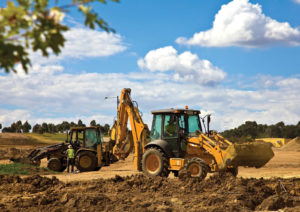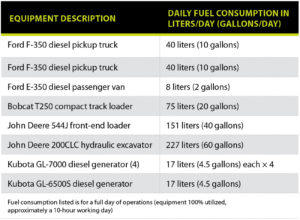From the Geosynthetics Research Institute’s 24th conference, 2011.The articles in this series encompass all types of geosynthetics and their applications viewed from the context of sustainability. Traditional solutions are compared with geosynthetic solutions from both cost and carbon footprint perspectives. (from the Geosynthetic Research Institute’s 24th conference, 2011)

Abstract
In April 2010, GSE released a technical note titled “Geosynthetics lower CO2 emissions and energy consumption vs. traditional soils-based construction techniques.”
This document compared the environmental impact and energy consumption of a hypothetical geosynthetic installation with that of an installation using traditional soil (clay and stone) design and construction techniques. This analysis contained many assumptions that have already been improved upon with time.
The other presenters and papers in this conference have completed a more detailed and exacting analysis for similar situations and topics. While we were satisfied with the original analysis and stand by the conclusions stated therein, we wanted to improve the detail and accuracy of the analysis, particularly in the area of the energy consumption and CO2 emission related to the construction and installation process of the geosynthetic layers.

We believe that our industry should have as thorough knowledge as possible of the installation portion of the topic that is directly related to geosynthetic materials. The data and information presented in this paper is a summary of the energy (fuel) consumption and the resulting CO2 emissions for a geosynthetic installation in northeastern Texas. The site is a liquid impoundment with a footprint of approximately 15,000m2 (~3.8 acres) and a maximum depth of 13m (~45ft). The installation includes a geosynthetic leak detection layer and a geomembrane barrier. A summary of the machinery used, fuel consumption, and the resulting CO2 emissions levels are included.
Background
This installation is the re-lining of a site that previously had a geomembrane barrier.
The existing geomembrane barrier was aging and it was decided to install a new geosynthetic system over the existing geomembrane barrier which was not removed. Figure 1 illustrates the cross section of the new double geomembrane lined systems (with intermediate geonet) placed immediately over the existing geomembrane.

Table 1 presents a summary of the equipment used on-site and the daily fuel consumption. Two key factors were identified that would have a significant impact of fuel usage. Most important is the location of the material staging area relative to the site. Transportation of roll goods at this point is one or two rolls at a time and is usually done with a front-end loader or other relatively low-mileage equipment.
At locations where the distance between the staging area and the deployment site is large—distances of a mile or more are not uncommon—this can cause a significant increase in fuel consumption. Also, at more remote sites, available lodging for the installation crews can be located 80km (~50 miles) or more from the site, resulting in long daily commutes. That said, neither of these latter situations occurred at this site.
This equipment was used by a crew of 10 installation workers with one supervisor. Installation began in late November and concluded just prior to Christmas. The team was on site for 22 days.
The total installed area (all layers) was ~46,000 square meters (~11.4 acres). This fairly slow installation pace was the result of several unique installation details: (i) the installation of two drainage (leak-detection) channels running the length of the site; and (ii) the adjoining sumps and the installation crew being responsible for all aspects of the anchor trench surrounding the peak of the slopes. This time duration also includes full leak-detection surveys of both the secondary and primary geomembrane layers.
During this installation process, fuel usage was a total of 3,255 liters (860 gallons). This results in CO2 emissions of 8,560 kg. The fuel usage compares to an estimate of 190 liters (50 gallons)/acre fuel consumption that was used in the initial calculations for the technical note mentioned above.
With an installed area of ~46,000m2 (~11.4 acres), using the estimates made in the technical note, the expected fuel usage was ~2,160 liters of fuel (570 gallons).
Conclusions
Actual fuel usage (and resulting CO2 emissions) for the installation portion of this “real world” project was 50% higher than predicted in the original estimation.
Based on this analysis, we would propose a figure of 300 liters (80 gallons) of fuel consumed per acre of geosynthetic installed. However, the contribution of the geosynthetic installation was estimated to be less than 2% of the total energy consumption and CO2 emissions for the entire project.
Boyd Ramsey is chief engineer at GSE Lining Technology LLC in Houston. He is chairman of the Geosynthetic Materials Association’s executive council.
Chris Eichelberger is director of business development with American Environmental Group Ltd. in Richfield, Ohio.
The articles in this series encompass all types of geosynthetics and their applications viewed from the context of sustainability. Traditional solutions are compared with geosynthetic solutions from both cost and carbon footprint perspectives. (from the Geosynthetic Research Institute’s 24th conference, 2011)
Acknowledgements
The authors would like to acknowledge Earl Morris, Jon Edens, and Ron Zunker of American Environmental Group Ltd. (AEG) for their contributions and assistance.
Bibliography
Davis, Stacy C. et al. Transportation Energy Data Book (Edition 28 of ORNL-5198), U.S. Department of Energy, 2009 (Current Edition #30 available at: http://cta.ornl.gov/data/index.shtml).
Goleman, Daniel. “Ecological Intelligence: How knowing the hidden impacts of what we buy can change everything,” New York: Broadway Books, 2009.
Hammond, Geoff and Jones, Craig. “Inventory of Carbon and Energy (ICE)” N.p., April 2, 2010, (www.bath.ac.uk/mech-eng/sert/embodied/).
Heerten, Georg. “Reduction of Climate-Damaging Gases in Geotechnical Engineering by Use of Geosynthetics,” The International Symposium on Geotechnical Engineering, Ground Improvement, and Geosynthetics for Sustainable Mitigation and Adaptation to Climate Change including Global Warming, (2009), (www.naue.com/content-Ma/admin/img/pool/20100112103548.pdf).
“Calculation Tools,” The Greenhouse Gas Protocol Initiative April 6, 2010.
“Forschungsstelle für Energiewirtschaft E.V.” Research Centre for Energy Economics. April 5, 2010.
“Sustainableengineering.com,” Stagnito Media. March 22, 2010.
 TEXTILES.ORG
TEXTILES.ORG


